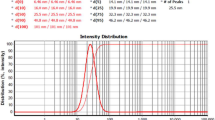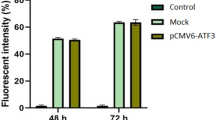Abstract
The cervical cancer is characterized as a public health problem. The human papillomavirus, especially the high-risk types 16 and 18, is present in 99.7% of cases of invasive cervical cancers. Due to high prevalence, the search for new drugs for the treatment is continuous. The apocynin, compound belonging to the class of catechol-methoxy acetophenone, has been used as an effective and non-toxic inhibitor of the NADPH oxidase complex, in many experimental models. Some early studies have indicated that apocynin also exerts antiproliferative activity inducing cell death by apoptosis. Thus, we evaluated the effect of apocynin in cervical epithelial cells infected by human papillomavirus 16 (SiHa cells) by analyzing oxygen species production, cell cycle, cell morphology, cell volume, membrane integrity and mitochondria membrane potential. Our data showed that apocynin induces antiproliferative effects by decreasing reactive oxygen species production and inducing cell cycle arrest, activating pathways that induce apoptosis cell death.







Similar content being viewed by others
References
Barbieri SS, Cavalca V, Eligini S, Brambilla M, Caiani A, Tremoli E, Colli S (2004) Apocynin prevents cyclooxygenase 2 expression in human monocytes through NADPH oxidase and glutathione redox-dependent mechanisms. Free Radic Biol Med 37(2):156–165
Bedard K, Krause KH (2007) The NOX family of ROS-generating NADPH oxidases: physiology and pathophysiology. Physiol Rev 87(1):245–313
Benedyk M, Sopalla C, Nacken W, Bode G, Melkonyan H, Banfi B, Kerkhoff C (2007) HaCaT keratinocytes overexpressing the S100 proteins S100A8 and S100A9 show increased NADPH oxidase and NF-kappaB activities. J Invest Dermatol 127(8):2001–2011
DeFilippis RA, Goodwin EC, Wu L, DiMaio D (2003) Endogenous human papillomavirus E6 and E7 proteins differentially regulate proliferation, senescence, and apoptosis in HeLa cervical carcinoma cells. J Virol 77(2):1551–1563
Dunne EF, Unger ER, Sternberg M, McQuillan G, Swan DC, Patel SS, Markowitz LE (2007) Prevalence of HPV infection among females in the United States. JAMA 297(8):813–819
Freinbichler W, Colivicchi MA, Stefanini C, Bianchi L, Ballini C, Misini B, Weinberger P, Linert W, Vareslija D, Tipton KF, Della Corte L (2011) Highly reactive oxygen species: detection, formation, and possible functions. Cell Mol Life Sci 68(12):2067–2079
Hopfl R, Heim K, Christensen N, Zumbach K, Wieland U, Volgger B, Widschwendter A, Haimbuchner S, Muller-Holzner E, Pawlita M, Pfister H, Fritsch P (2000) Spontaneous regression of CIN and delayed-type hypersensitivity to HPV-16 oncoprotein E7. In Lancet, England, p 1985–1986
INCA (2012) Incidência de Câncer no Brasil. [Internet]. http://www.inca.gov.br/estimativa/2012/index.asp?ID=2015. Accessed 10 Sept 2015
Koeppen BM, Stanton BA (2007) Regulation of body fluid osmolality: regulation of water balance. Renal Physiol 24:3263.
Kuznetsov AV, Margreiter R, Amberger A, Saks V, Grimm M (2011) Changes in mitochondrial redox state, membrane potential and calcium precede mitochondrial dysfunction in doxorubicin-induced cell death. Biochim Biophys Acta 1813(6):1144–1152
Lee YJ, Lee JH, Han HJ (2006) Extracellular adenosine triphosphate protects oxidative stress-induced increase of p21(WAF1/Cip1) and p27(Kip1) expression in primary cultured renal proximal tubule cells: role of PI3K and Akt signaling. J Cell Physiol 209(3):802–810
Liu Z, Liu Y, Peng D (2015) Carboxylation of multiwalled carbon nanotube attenuated the cytotoxicity by limiting the oxidative stress initiated cell membrane integrity damage, cell cycle arrestment and death receptor mediated apoptotic pathway. J Biomed Mater Res A
MacLachlan TK, Sang N, Giordano A (1995) Cyclins, cyclin-dependent kinases and cdk inhibitors: implications in cell cycle control and cancer. Crit Rev Eukaryot Gene Expr 5(2):127–156
Mejia EM, Hatch GM (2015) Mitochondrial phospholipids: role in mitochondrial function. J Bioenerg Biomembr 48, 99–112.
Mohan S, Abdul AB, Abdelwahab SI, Al-Zubairi AS, Sukari MA, Abdullah R, Elhassan Taha MM, Ibrahim MY, Syam S (2010) Typhonium flagelliforme induces apoptosis in CEMss cells via activation of caspase-9, PARP cleavage and cytochrome c release: its activation coupled with G0/G1 phase cell cycle arrest. J Ethnopharmacol 131(3):592–600
Munoz N, Mendez F, Posso H, Molano M, van den Brule AJ, Ronderos M, Meijer C, Munoz A (2004) Incidence, duration, and determinants of cervical human papillomavirus infection in a cohort of Colombian women with normal cytological results. J Infect Dis 190:2077–2087
Okada H, Mak TW (2004) Pathways of apoptotic and non-apoptotic death in tumor cells. Nat Rev Cancer 4(8):592–603
Pilch H, Gunzel S, Schaffer U, Tanner B, Brockerhoff P, Maeurer M, Hockel M, Hommel G, Knapstein PG (2001) Human papillomavirus (HPV) DNA in primary cervical cancer and in cancer free pelvic lymph nodes—correlation with clinico-pathological parameters and prognostic significance. Zentralbl Gynakol 123(2):91–101
Pisani P, Bray F, Parkin DM (2002) Estimates of the world-wide prevalence of cancer for 25 sites in the adult population. Int J Cancer 97(1):72–81
Qin Y, Pan X, Tang TT, Zhou L, Gong XG (2011) Anti-proliferative effects of the novel squamosamide derivative (FLZ) on HepG2 human hepatoma cells by regulating the cell cycle-related proteins are associated with decreased Ca(2+)/ROS levels. Chem Biol Interact 193(3):246–253
Spangle JM, Munger K (2010) The human papillomavirus type 16 E6 oncoprotein activates mTORC1 signaling and increases protein synthesis. J Virol 84(18):9398–9407
Stefanska J, Pawliczak R (2008) Apocynin: molecular aptitudes. Mediat Inflamm 2008:106507
Suzuki S, Pitchakarn P, Sato S, Shirai T, Takahashi S (2013) Apocynin, an NADPH oxidase inhibitor, suppresses progression of prostate cancer via Rac1 dephosphorylation. Exp Toxicol Pathol 65(7-8):1035–1041
Suzuki S, Shiraga K, Sato S, Punfa W, Naiki-Ito A, Yamashita Y, Shirai T, Takahashi S (2013) Apocynin, an NADPH oxidase inhibitor, suppresses rat prostate carcinogenesis. Cancer Sci 104(12):1711–1717
Yu SP, Choi Dw (2000) Ions, cell volume, and apoptosis. Proc Natl Acad Sci USA 97:9360–9362
Zhang Y, Zhao W, Zhang HJ, Domann FE, Oberley LW (2002) Overexpression of copper zinc superoxide dismutase suppresses human glioma cell growth. Cancer Res 62(4):1205–1212
Acknowledgements
This study was supported by Conselho Nacional de Desenvolvimento Científico e Tecnológico (CNPq), Coordenação de Aperfeiçoamento de Pessoal de Nível Superior (Capes), Fundação Araucária. Programa de Pós Graduação em Biociências Aplicadas a Farmácia da Universidade Estadual de Maringá.
Author information
Authors and Affiliations
Corresponding author
Ethics declarations
Conflict of interest
The authors declare that they have no competing interests.
Rights and permissions
About this article
Cite this article
Lima, N.A., Santana, N.d.C.S., de Lima, N.C.A. et al. Antiproliferative effect of apocynin in cervical epithelial cells infected by HPV 16 involves change of ROS production and cell cycle. Med Chem Res 26, 2853–2860 (2017). https://doi.org/10.1007/s00044-017-1984-9
Received:
Accepted:
Published:
Issue Date:
DOI: https://doi.org/10.1007/s00044-017-1984-9




